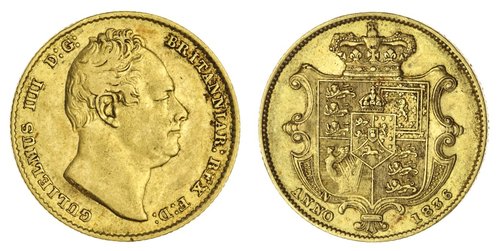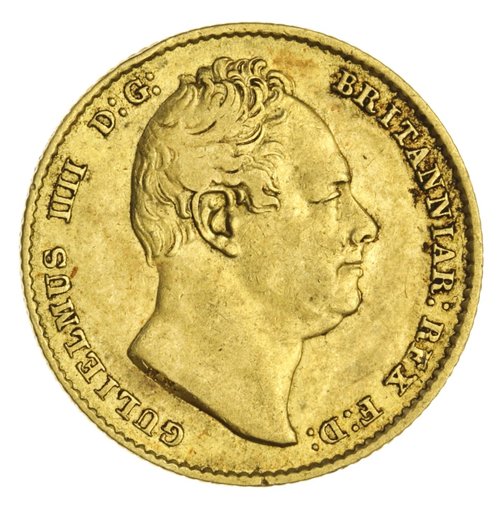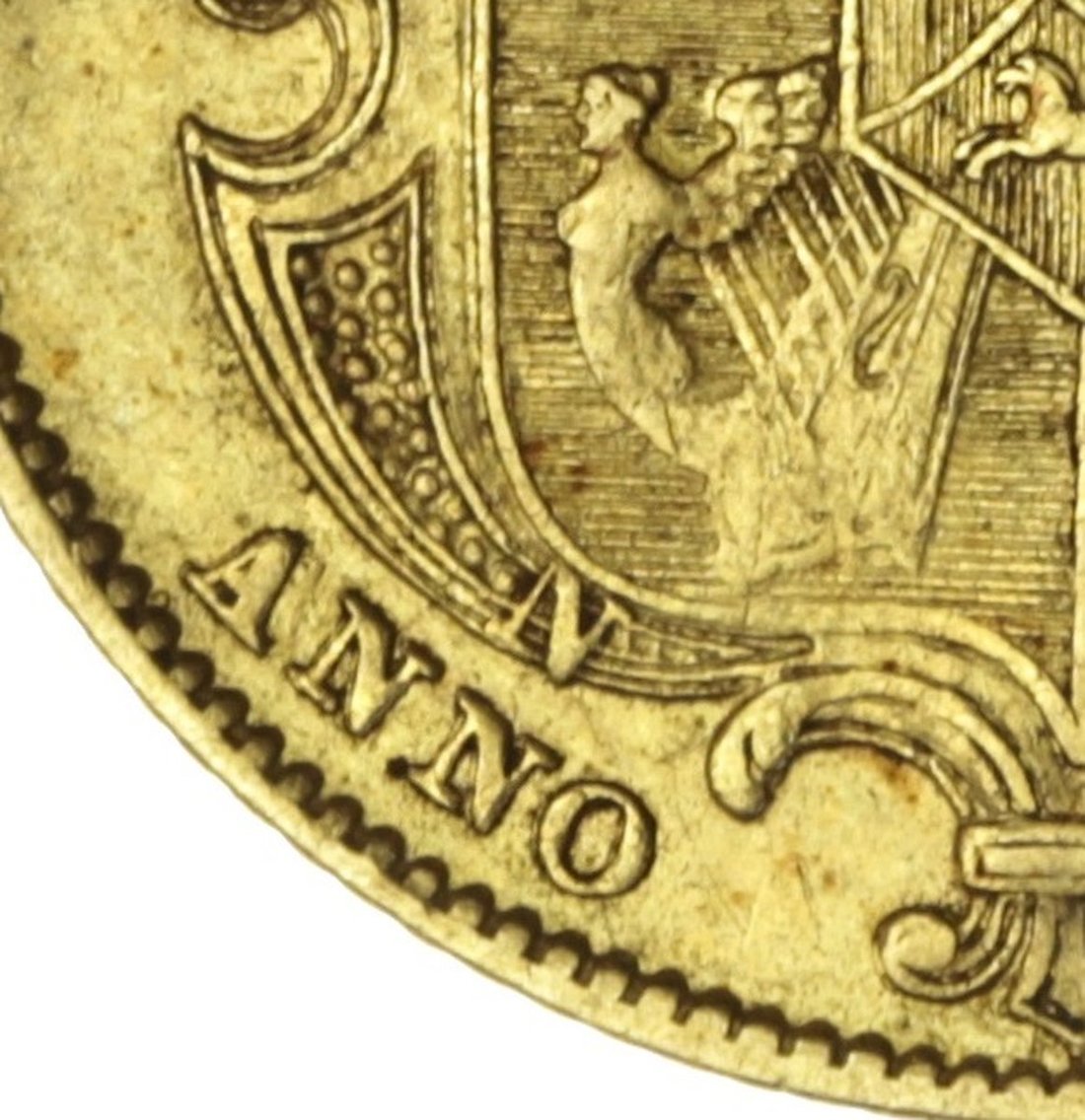Auction: 20005 - The Stratos Sale of Spectacular English Gold Coins
Lot: 134
(g) William IV (1830-1837), Sovereign, 1836, second bust right, rev. crowned shield on mantle,
Provenance
The Apollo Collection
NGC AU50 (Certification #5880294-005) [Variety Not Recognised]
https://www.ngccoin.com/certlookup/5880294-005/50/
Many adjectives could have been used to describe this error, ranging from the mundane to the seriously bizarre, but as yet no convincing explanation for this truly unique Royal Mint 'error' has been forthcoming ever since the variety was first reported in 1989.
A political statement?
One argument follows the political coup of Louis-Napoléon Bonaparte at Strasbourg on 29 October 1836 and his attempts to overthrow the incumbent King Louis-Philippe. The 'N' motif, as the Bonaparte emblem, could have been secreted onto this coin as a subtle demonstration or perhaps even representation of the English support for his Napoleonic cause. Such a motivation whilst quite fanciful, is not entirely without historical basis given the recorded sentiments of the crowd mobbing Bonaparte's lodgings at 30 George Street in 1831. Amongst his supporters was the Count Lennox, Innocent-Louis Goubaud, and Louis Belmontet, all of whom obtained funds from Bonaparte's mother to mount a failed insurrection that Summer. Significant too is that a mere two decades before this coin, the Royal Mint had been used to strike French specie in the name of the exiled Louis XVIII, so it is probable that mint workers and officials would have engaged actively in the public surrounding these events. However, one may also look to the other ground-breaking political events of William's reign, from the Reform Bill (1832) to the Slavery Abolition Act (1833), although mercifully in the case of the latter, no historical precedent for such an inflammatory device is found in any contemporary literature.
A Royal Mint racketeering rumble?
On a separate track, further investigation at the Royal Mint has revealed two other objects in their collection of matrices and dies for the Sovereign of William IV bearing an erroneous N stamped clear from the central design, but sadly no further clarity on the meaning of this punch. One highly practical reason for the error could be the deliberate marking of dies by Mint officials to detect the malfeasance of workers. The principle being that if a marked coin were discovered on your person, you would have no legitimate explanation for it. A similar ruse was used to detect a thief at the Philadelphia Mint in 1875, who was discovered with thirty-three 'marked' One Cent coins in his clothing. This would also account for the extreme rarity of the variety in circulation, and the seemingly deliberate placement of the mark, as if disguised within the wider Mantle detailing. There is also clear evidence that Mint officials had problems with theft of metal from the mint, as in the case of the story of 'Williamson and Austin, of Lambeth Street', who were found to have 'a blank sovereign on their possession, the property of His Majesty's mint' (The Globe, 16 March 1832), or indeed the earlier story of 'G. Keith, who carried off gold blanks from the Mint' (Dorset County Chronicle, 4 February 1830). However exciting this possibility, it would not account for the apparent test or trial punches held within the Museum collection, which would point towards a more practical reason for their existence.
A Mint worker's claim to fame?
Precedent for the incorporation of designer's initials into coin designs is readily seen on the numismatic portraiture of this period with engraver's signatures apparent on the truncation of each model. However more obscure is the buried initials of William Wellesley-Pole and William Wyon in the floral sprays of the 1816 and 1817 'type 1' Halfcrowns. Whilst incuse, they provide the most obvious parallel for the present coin, where, as has been previously observed, the N is carefully integrated. Perhaps a mint worker was familiar with this hidden feature of the earlier Halfcrowns, or had even worked on them, and therefore thought himself equally deserving of numismatic notoriety? A major counter to this idea would be the level of mint regulation and access to punches, and indeed the great likelihood of there being many examples of this across the British numismatic corpus if standards were truly so lax - at present no other example has been identified - and again why would there be test strikings?
A scientific experiment?
Logically this leads us on to the question of scientific experimentation. As with the 1819 Sovereign (lot 115), assessment of circulation wear and alloy purity testing were all being conducted at the Royal Mint during this time and would continue well into the reign of Queen Victoria through the likes of the 'Ansell' 'brittle-gold' Sovereign issues of 1859; the '827' ingot coins of 1863, and even the Palladium-Hydrogenium strikings of Half-Sovereigns by T. Graham in 1869. It is worth also recalling that the first half of William's reign saw a concerted effort at the Mint to introduce a new model for the Half-Sovereign, first introduced to circulation in 1834, but withdrawn and replaced by the old standard by 1836. Perhaps alongside this process, and in a longstanding Mint tradition of marking the source of the bullion, the N is representative of a source of supply, or a new composition of alloy that was not subsequently adopted. Given the known history of Mint operations, the presence of trial strikings and the transitional nature of production at the time, at present, this explanation seems the most feasible for this otherwise entirely mystifying variety.
The corpus can be constructed as follows. The dates in brackets show the earliest record of each example, with those in bold identifying the known offerings in the present market. As noted by the condition reports, the present example is the best presently offered, either in core grade or in 'honesty' of appearance, and is evidently amongst the finest of the 12 examples known:
1. (1989) - 'An example was examined by the Royal Mint, and is only in fine condition'. Mr B Williams (Shetland); Roy Stirling (Cheshire), FPL, October 1995, illustrated in 'The Gold Sovereign', Michael Marsh, (2Nd Edition, Cambridge, 1999) plate 10, page 24.
2. (2003) - DNW 59, 7 October 2003, lot 761, 'sometime cleaned but GVF [unsold]; SJA 12, 5 November 2009 lot 709, 'lightly burnished with a tiny dig below bust' [unsold]; SJA 13, 6 May 2010, lot 899 [£12,800]; SJA 16, 7 December 2010, lot 342 [£8,000]. This example studied by Michael Marsh.
3. (2005) - Spink 175, 28 September 2005, lot 1701, 'lightly smoothed on edge at 6 o'clock, two minor edge nicks, GVF' [£12,500]; Bentley, Baldwins 73, 8 May 2012, lot 31 [£12,000]
4. (2008) - SJA 7, 8 February 2008, Lot 610, 'nick on adam's apple, about F' [£3,400]
5. (2009) - SJA 11, 8 May 2009, lot 375, 'almost VF, the reverse better' [unsold]
6. (2010) - SJA 14, 30 September 2010, lot 411, 'good VF, the reverse better' [withdrawn]; SJA 28, 24 June 2014, lot 615, 'light rubbing on top of hair, gVF' [£6,400]
7. (2012) - Spink 212, 28 March 2012, lot 1044 - "F" [£3,400]; Ingram, private listing [£7,950]
8. (2013) - SJA 23, 4 February 2013, lot 323, 'a really good F' [£7,600]; LCA 152, 4 June 2016, lot 3527 [unsold]; LCA 153, 4 June 2016, lot 3427 [£4,200]
9. (2015) - LCA 150, 5 September 2015, lot 2946 - 'bagmarks, VF, in CGS holder, graded 50' [£9,000]; Stanley Gibbons Investments, CM002002, subsequently provenance unsubstantiated, private listing [£15,000]
10. (2015) - Warwick & Warwick 772, 19 August 2015, lot 510 [£3,068 incl. Premium]; LCA 151, 5 December 2015, lot 3054 [£5,000]; BSJ 9, 21 September 2017, lot 1668 - 'scratches on reverse, F' [£3,600]; LCA 161, 2 June 2018, lot 1945 - 'the reverse with some thin scratches, very good / fine' [£5,500]
11. (2020) - AMR Coins, 'polished, fair', private listing [£3,950 - Reserved]; Sovereign Rarities, private listing (ref. EI16024) [£6,000]
12. This coin
Subject to 20% VAT on Buyer’s Premium. For more information please view Terms and Conditions for Buyers.
Sold for
£12,000
Starting price
£2500











